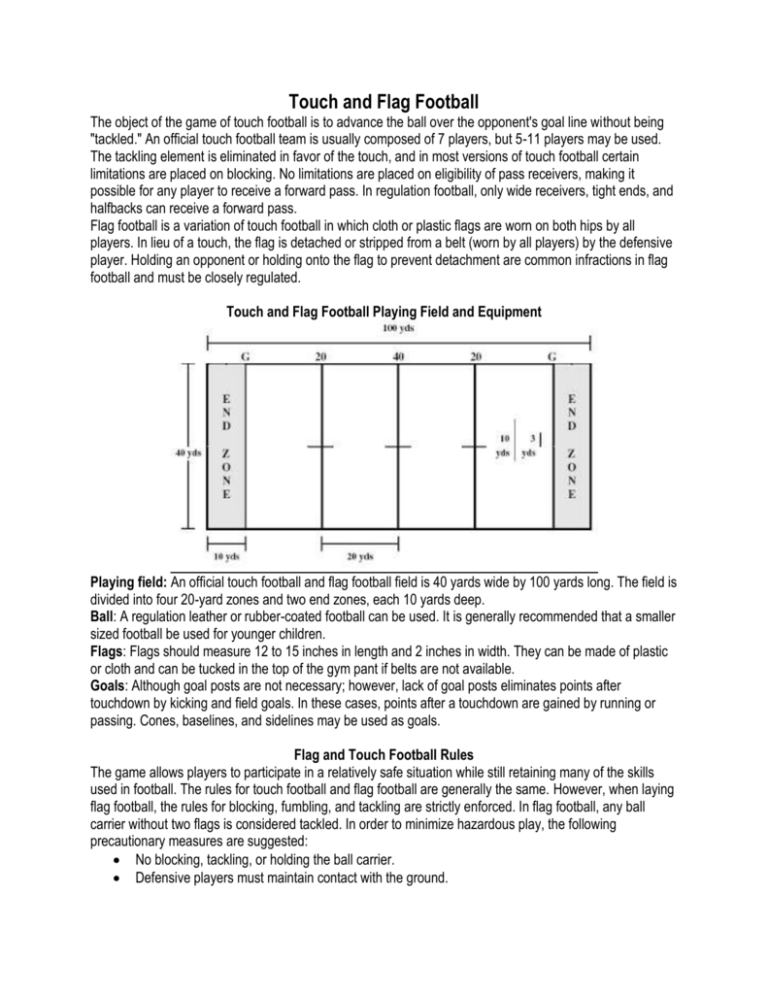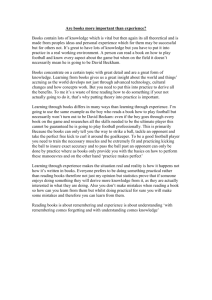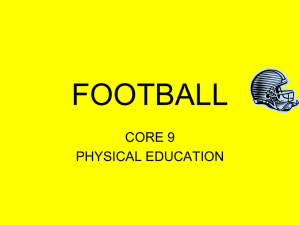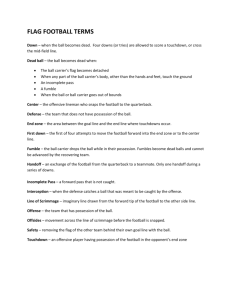Touch and Flag Football - Physical Education, Health, and Dance
advertisement

Touch and Flag Football The object of the game of touch football is to advance the ball over the opponent's goal line without being "tackled." An official touch football team is usually composed of 7 players, but 5-11 players may be used. The tackling element is eliminated in favor of the touch, and in most versions of touch football certain limitations are placed on blocking. No limitations are placed on eligibility of pass receivers, making it possible for any player to receive a forward pass. In regulation football, only wide receivers, tight ends, and halfbacks can receive a forward pass. Flag football is a variation of touch football in which cloth or plastic flags are worn on both hips by all players. In lieu of a touch, the flag is detached or stripped from a belt (worn by all players) by the defensive player. Holding an opponent or holding onto the flag to prevent detachment are common infractions in flag football and must be closely regulated. Touch and Flag Football Playing Field and Equipment Playing field: An official touch football and flag football field is 40 yards wide by 100 yards long. The field is divided into four 20-yard zones and two end zones, each 10 yards deep. Ball: A regulation leather or rubber-coated football can be used. It is generally recommended that a smaller sized football be used for younger children. Flags: Flags should measure 12 to 15 inches in length and 2 inches in width. They can be made of plastic or cloth and can be tucked in the top of the gym pant if belts are not available. Goals: Although goal posts are not necessary; however, lack of goal posts eliminates points after touchdown by kicking and field goals. In these cases, points after a touchdown are gained by running or passing. Cones, baselines, and sidelines may be used as goals. Flag and Touch Football Rules The game allows players to participate in a relatively safe situation while still retaining many of the skills used in football. The rules for touch football and flag football are generally the same. However, when laying flag football, the rules for blocking, fumbling, and tackling are strictly enforced. In flag football, any ball carrier without two flags is considered tackled. In order to minimize hazardous play, the following precautionary measures are suggested: No blocking, tackling, or holding the ball carrier. Defensive players must maintain contact with the ground. Ball carriers may not employ straight-arm or body contact. Length of Game Four 10- to 12-minute periods constitute a game with a 1-minute rest between periods and a 5minute rest between halves. Games may also be divided into two 20-minute halves with a 5-minute rest period. Overtime Tie games may be decided by one of the following methods: Award the game to the team with the greater number of penetrations inside the opponent’s 20-yard line. Award the game to the team with the greater number of first downs. Give each team four downs from the 20-yard line and award the game to the team advancing the ball farther. Timeouts Each team is allowed two timeouts per half. Timeouts are taken: When the ball goes out of bounds. After a score is made. While a penalty is being enforced. At the direction of the referee. At the end of each period. Scoring Scoring is the same as regulation football: Touchdown (6 points) A point after touchdown (1 point by kicking, 2 points by running or passing) Field goal (3 points) (PE no field goals) Safety (2 points) Players and Officials Players A team consists of seven players, although fewer or more players may be used by mutual consent. The offensive team must have a at least three players on the line of scrimmage when the ball is put into play. Any number of substitutions may be made at any time during a stoppage of play. Substitutes Any number of substitutions may be made at any time during the game. Substitutions must report to the referee Officials Officials consist of a referee, an umpire, and linesman Flag and Touch Football Playing Regulations Starting the Game A toss of a coin by the referee determines which team has the choice of kicking off, receiving, or goals. The loser of the toss has the choice of remaining options. Privileges of choice are reversed at the beginning of the third period. Putting the Ball in Play The ball is put into play by a place kick (PE punt) from the kicker’s 20-yard line (PE first cone/marker) on at the start of the game, after a score, and at the beginning of the third quarter. Defensive players must be 10 yards away when the ball is kicked. Members of the kicking team must be behind the ball. The ball must travel 10 yards or be re-kicked (PE pass midfield). If the ball goes out of bounds after 10 yards, the opponent has the choice of beginning play where it went out of bounds or placing it on his or her own 20-yard line (PE first cone/marker). If the ball is kicked into the end zone and the opponents choose not to run it back, play begins on their 20-yard line (PE first cone/marker). Fumbled Ball A fumbled ball at any time is considered a dead ball and belongs to the team that committed the fumble. The down and point to be gained remains the same. A fumbled forward pass is ruled as an incomplete pass. Downed Ball In touch football, the ball is dead or the player is downed when an opponent touches him or her with one hand between the shoulders and knees. In flag football, the ball is downed or the player is tackled when one flag is detached from the belt or the ball carrier loses his or her flag. First Downs Each team has four chances to move the ball from one 20-yard zone to the next (cone/marker to the next). If a team is not successful at moving the ball from one zone to the next in four downs, the ball is awarded to the opponents on the sport where the last stoppage of play occurred. Passing All players on both teams are eligible to catch passes. Forward passes may be thrown from any point back of the line of scrimmage. Lateral passes may be thrown anywhere on the field. Any number of passes may be thrown in a series of downs. Flag and Touch Football Penalties 5-Yard Penalty Infractions (Taken from Line of Scrimmage) PE Take 5 steps Offside Delay of game Less than three players on the line of scrimmage Illegal motion Unnecessary roughness: pushing, tackling, shoving, tripping, holding Clipping Pass interference Flagrant rule violations result in ejection from the game. 10-Yard Penalty Infractions (From Spot of Foul) PE Take 10 Steps Illegal use of hands Illegal block Unnecessary roughness (push, tackle, shove, trip, holding) Unsportsmanlike conduct Clipping Pass interference Flag and Touch Football Terms Backs Players on the team who are stationed behind the linemen and who ordinarily carry or pass the ball on offense. Backward pass Play in which the ball is thrown or passed in any direction except toward the opponent's goal. Any player may make a backward pass. Block Action of offensive linemen and backs in which they used their bodies to ward off defensive players from the ball carrier. Button Hook A forward pass play in which the receiver runs toward the defender, turns, and runs back toward the passer to receive the pass. Clipping A blocking action in which a player throws his or her body across the back of the leg(s) of a player not carrying the ball. This can cause injury and is a personal foul. Cut-Back An offensive maneuver in which the back starts wide and then cuts back toward center of the line. Fair Catch A player may make a fair catch on a kickoff, return kick, or kick from scrimmage by raising a hand clearly above his or her head before making the catch. He or she may not be tackled or take more than two steps after receiving the ball. Flanker An offensive maneuver in which a layer lines up nearer the sideline than a designated opponent. Forward Pass An offensive play in which the ball is thrown toward the line of scrimmage. Handoff An offensive play in which one back hands off the ball to another back who attempts to advance the ball. Lateral Pass An offensive play in which the ball is passed sideward or backward to the line of scrimmage. Line of Scrimmage An imaginary line, or vertical plane, passing through the end of the ball nearer a team’s goal line and parallel to the goal lines. There is a line of scrimmage for each team, and the area between the two lines is called the neutral zone. Any player of either team is offside if he or she encroaches upon the neutral zone before the ball is snapped. Neutral zone The imaginary line that passes between the lines of scrimmage of each team. Either team is offside if it moves across the neutral zone before the ball is snapped. Offside When an offensive player is ahead of the ball before it is snapped. (The penalty is five yards.) Safety A score made when a free ball, or one in possession of a player defending his or her own goal, becomes dead behind the goal, provided the impetus that caused it to cross the goal was supplied by the defending team. Screen Pass An offensive maneuver in which a nave of eligible receivers converge in the area where a pass is to be thrown. Shotgun Offense A formation in which the quarterback lines up five to six yards behind the center. Usually one or both halfbacks may line up one to two yards on either side of the quarterback and one yard in front of the quarterback. Shovel Pass An offensive maneuver in which a pass is thrown, underhand, usually forward to a back behind the line of scrimmage. Touchback When a ball that is legally in possession of a player guarding his own goal becomes dead behind the opponent’s goal line, provided the impetus that caused it to cross the goal line was supplied by an opponent. No pints are scored on the play, and the ball is put in lay at the 20-yard line. Offensive Positions and Rules Offensive Positions: QB: Quarterback The quarterback guides the offense during the game. The quarterback calls the cadence and “takes the snap” meaning he receives that ball from the center and can then hand it off to the running back or pass the ball to a receiver. RB: Running Back The running back is the primary ball carrier for running plays. The RB lines up in the back field and moves forward at the snap to receive a hand-off from the QB. If the ball is not handed to the running back that player can them go out for a pass in the same way as a wide receiver. OG: Offensive guard The inner two members of the offensive line, whose jobs are to block for and protect the quarterback and ball carriers. C: Center The center handles the snap of the ball from the LOS to the quarterback. In flag football rules the center is then eligible to act as a wide receiver and go out for a pass. WR: Wide Receiver The receivers run routes down field and try to catch passes that are thrown from the quarterback in order to advance the ball or score points. Teams must have a quarterback, center, and wide receiver on every play A huddle must be used between offensive plays; except inside 2 minutes to play in the game A forward pass that falls incomplete is spotted where the pass was thrown All players are eligible to receive a pass from the quarterback A team must change the quarterback after every touchdown Players are not allowed to flag guard. The play is over at the spot of the flag guard. Defensive Positions and Rules DL: Defensive Line Defensive tackle: The inner two members of the defensive line, whose jobs are to maintain their positions in order to stop a running play or run through a gap in the offensive line to pressure the quarterback or disrupt the backfield formation. Defensive end: The outer two members of the defensive line. Generally, their jobs are to overcome offensive blocking and meet in the backfield, where they combine to tackle the quarterback or ball carrier. On running plays to the outside, they're responsible for forcing the ball carrier either out of bounds or toward (into) the pursuit of their defensive teammates. CB: Cornerback The inner two members of the offensive line, whose jobs are to block for and protect the quarterback and ball carriers. LB: Linebacker Opposite to how safeties play (i.e. pass first then run), the line backers guard against the run first then pass. If the leagues allows for blitzing the line backers will also be the primary rusher against the quarterback. Once any threat of a running play is eliminated the line backers should drop back into pass coverage. S: Safety Defensive player who plays the deep pass. They defend against the pass by attempting to prevent the offensive receiver from catching the ball, either by knocking the ball down or by catching the ball before the intended receiver can. Defensive teams are allowed to play man-to-man coverage or zone - coverage (area) Players must allow the offensive 5 seconds before rushing the quarterback (5 count) The ball is downed or the player is tackled when one flag is detached from the belt or the ball carrier loses his or her flag.





